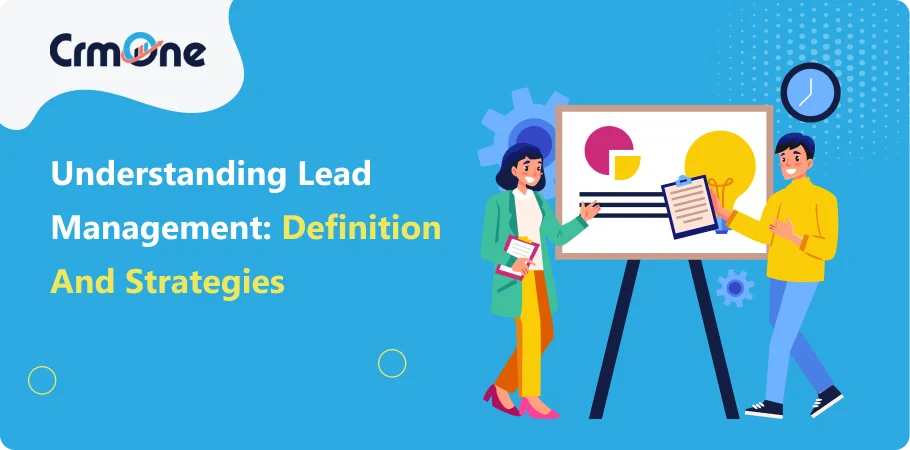In the dynamic landscape of sales and marketing, the concept of lead management plays a pivotal role in driving business growth. From defining the process to implementing effective strategies, lead management serves as the backbone for converting prospects into loyal customers. In this comprehensive guide, we delve into the definition of lead management, explore key strategies, and highlight the importance of integrating sales and marketing efforts seamlessly.
We’ll unpack the lead lifecycle, from initial lead capture to nurturing and qualification, equipping you to identify high-value prospects and optimize your sales funnel. By aligning sales and marketing through a shared lead management strategy, you’ll discover how to leverage valuable customer data to personalize outreach and ultimately drive conversions.
Lead Management Definition

Lead management encompasses the systematic process of capturing, nurturing, and converting leads into customers. It involves the strategic handling of potential clients throughout their journey, from the initial interaction to the final conversion.
An effective lead management software fosters communication and collaboration between marketing and sales teams. By qualifying leads and prioritizing them based on their needs and buying intent, businesses can ensure their sales reps focus on the most promising opportunities, ultimately boosting sales efficiency and revenue growth.
Strategies for Effective Lead Management

Crafting a Robust Lead Management Strategy
Imagine lead management as the bridge connecting sales and marketing. A strong strategy acts as the blueprint for this bridge, ensuring a smooth flow of qualified leads. When both teams share clear goals, they can work together seamlessly. This united front translates into a powerful lead management strategy, ultimately driving business growth.
Nurturing Leads for Long-Term Success
Don’t just capture leads, cultivate them! Lead nurturing is all about building relationships. By providing personalized communication and relevant content tailored to their interests, you can turn prospects into brand advocates.
This trust-building strategy keeps them engaged as they navigate their buying journey, ultimately making them more receptive to your offerings.
Aligning Sales and Marketing Teams
Efficient collaboration between sales and marketing teams is crucial for smooth lead management. By harmonizing objectives and direct-to-consumer strategies, companies can improve lead quality and expedite the conversion process. This synergy ensures that both teams work in tandem, leveraging each other’s strengths to maximize results.
When sales and marketing are aligned, it streamlines communication, reduces friction, and enhances overall productivity. Ultimately, this collaboration leads to more effective targeting, stronger customer relationships, and increased revenue generation.
Maximizing Marketing Qualified Leads (MQLs)
Marketing qualified leads (MQLs) represent potential customers who have expressed interest in a company’s products or services. By giving precedence to MQLs, businesses can concentrate their resources on leads most likely to convert. This prioritization enables organizations to optimize their marketing efforts and allocate resources efficiently.
MQLs signify prospects who have engaged with the company’s marketing channels and are considered more promising than other leads. By focusing on MQLs, companies can enhance their conversion rates and streamline their sales processes. Ultimately, prioritizing MQLs aids businesses in maximizing their marketing ROI and driving sustainable growth.
Best Practices for Lead Management

Embracing Lead Management Best Practices
From maintaining data accuracy to implementing lead scoring systems, adhering to best practices is crucial for optimizing lead management processes. By following established guidelines, organizations can enhance efficiency and drive better results.
Leveraging Sales Automation
Sales automation tools can streamline repetitive tasks and streamline the sales process. By automating routine activities, sales teams can focus on high-value interactions and close deals more efficiently.
Lead Management Definition: Understanding the Core Concepts
In today’s dynamic business landscape, effective lead management is crucial for sustained growth and success. But what exactly does lead management entail, and why is it so important? Let’s delve into the definition of lead management and explore its key components and significance.
Book a CrmOne Demo
Experience the CrmOne simplicity and power. Our experts will show you the best ways to use it and answer your questions in real time. See how CRMOne fits your needs.
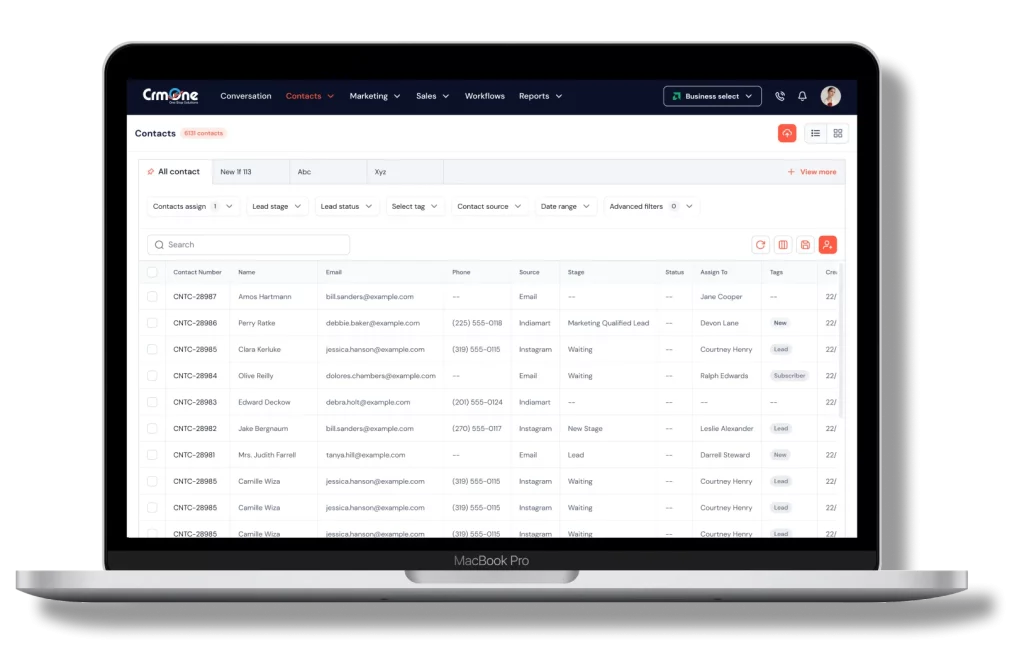
The Lead Management Process Unveiled
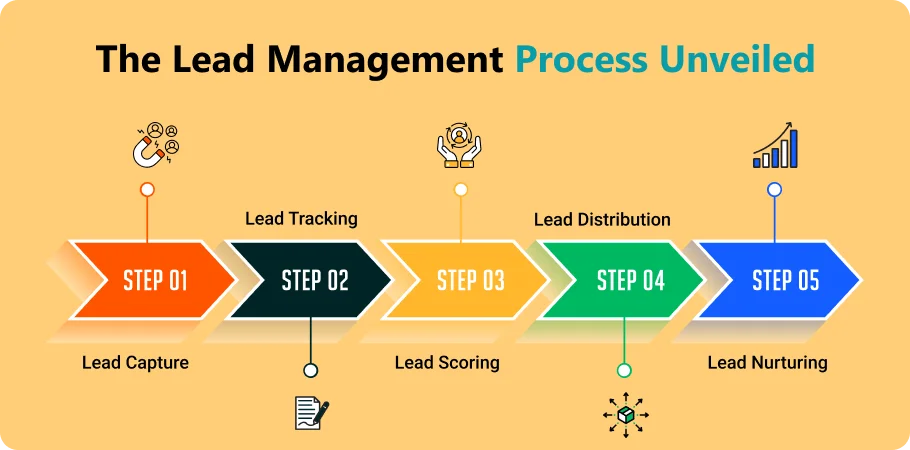
The lead management process comprises several stages, each with its specific objectives and actions. Let’s break down these stages to gain a comprehensive understanding:
Lead Generation:
The journey commences with lead generation, involving the identification and attraction of potential customers through diverse marketing channels and tactics. This initial stage aims to capture the attention of prospects and initiate their engagement with the company’s offerings.
Lead generation serves as the foundation for building relationships with potential customers and nurturing them through the sales funnel. It encompasses a range of activities geared towards sparking interest and creating opportunities for further interaction.
Lead Capture:
After leads are generated, they must be captured and inputted into the lead management system for subsequent processing. This step ensures that all potential opportunities are properly recorded and organized for further evaluation. Efficiently capturing and entering leads into the system facilitates smoother progression through the sales pipeline, enhancing overall productivity and effectiveness.
Lead Qualification:
Afterward, leads undergo assessment and qualification according to predetermined standards, guaranteeing that only top-tier prospects advance deeper into the sales pipeline. This process ensures that resources are allocated efficiently and efforts are focused on prospects most likely to convert, optimizing the overall sales performance.
Lead Nurturing:
Nurturing qualified leads involves tailored communication and precise marketing strategies aimed at fostering relationships and shepherding them along the purchasing path. This personalized approach ensures that prospects feel valued and engaged, leading to stronger connections and smoother transitions through the buying process.
Lead Scoring:
Lead scoring involves assigning numerical values to leads depending on their interactions, engagement, and readiness to buy, facilitating prioritization and resource distribution. This method streamlines the process by focusing efforts on leads showing higher potential for conversion, thus maximizing efficiency in resource allocation.
Lead Distribution:
Leads are allocated to sales representatives or teams following predefined guidelines and criteria, ensuring prompt follow-up and effective management. This systematic distribution guarantees that each lead receives appropriate attention and that resources are utilized efficiently.
By adhering to these predetermined rules, businesses can streamline their sales processes and enhance customer engagement. This approach enables organizations to maintain consistency in their follow-up efforts and maximize the potential for conversion.
Sales Engagement:
Sales representatives interact with leads, utilizing insights acquired through the lead management process to customize their strategies and facilitate conversions. By leveraging these insights, sales reps can personalize their approach, addressing the specific needs and preferences of each lead.
This tailored approach enhances the likelihood of successful conversions and fosters stronger customer relationships.
Lead Tracking:
Throughout the journey, leads are consistently monitored and tracked to evaluate their advancement, pinpoint any possible obstacles, and refine strategies to enhance conversion rates. This ongoing monitoring ensures proactive management of the sales pipeline, facilitating the identification and resolution of challenges, ultimately maximizing the effectiveness of conversion strategies.
Lead Conversion:
Lead management aims to convert leads into paying customers, thereby fueling revenue generation and fostering business expansion. This process focuses on guiding prospects through the sales journey effectively, ultimately maximizing sales performance and bolstering overall business growth.
Importance of Lead Management process
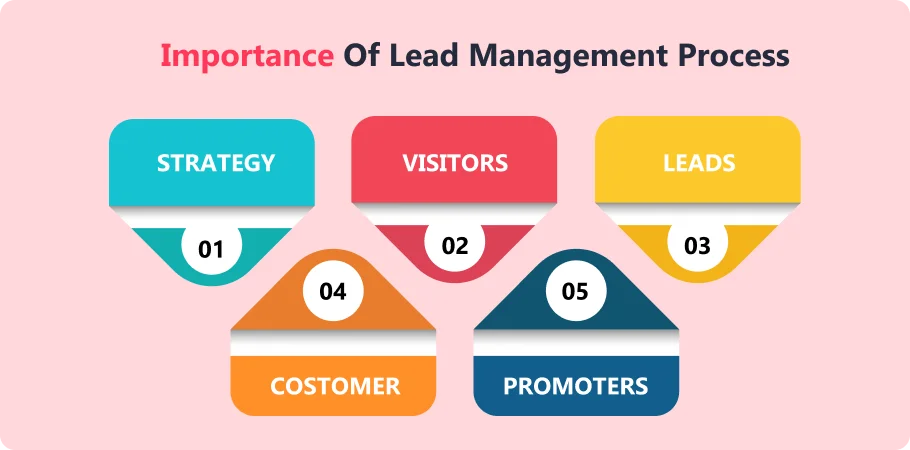
Enhancing Sales and Marketing Collaboration
Lead management plays a pivotal role in fostering collaboration between sales and marketing teams. By aligning strategies, sharing insights, and coordinating efforts, organizations can ensure a seamless transition of leads through the sales funnel, leading to higher conversion rates and improved ROI.
Maximizing Lead Engagement and Conversion
Effective lead management enables businesses to maximize lead engagement by delivering personalized experiences and timely communication. By nurturing leads with relevant content and targeted messaging, organizations can build trust, address pain points, and guide prospects towards conversion.
Optimizing Resource Allocation
By prioritizing and segmenting leads based on their level of engagement and propensity to buy, lead management helps organizations optimize resource allocation. Relevant sales team can focus their efforts on high-potential leads, thereby improving efficiency and productivity.
Key Components of Lead Management
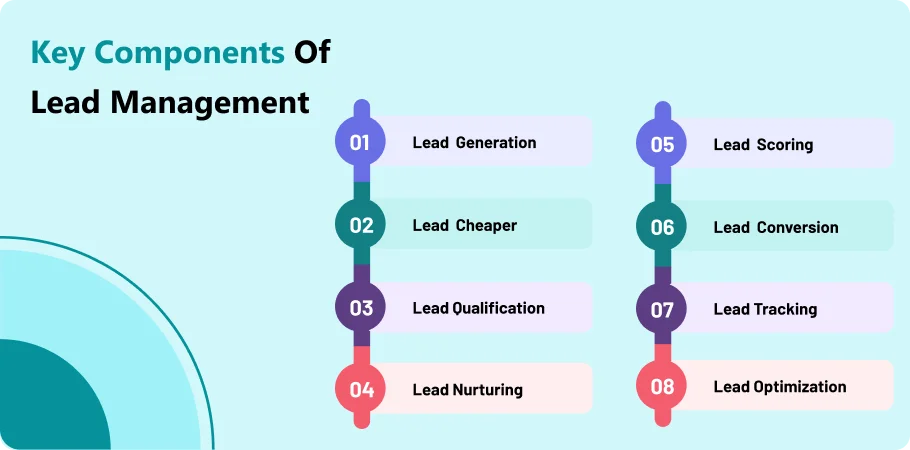
Lead Generation:
Lead generation is the initial step in the lead management process, focusing on attracting potential business clientele and collecting their contact information. Various tactics such as content marketing, email campaigns, social media engagement, and search engine optimization (SEO) are employed to generate leads and expand the customer base.
Lead Capture:
Once leads are generated, they need to be captured and entered into the lead management system for further processing. Lead capture mechanisms, such as online forms, landing pages, and interactive chatbots, facilitate the collection of essential lead generation process data and enable businesses to initiate communication with prospects.
Lead Qualification:
Not all leads are created equal. Lead qualification involves evaluating the quality and readiness of leads based on predefined criteria, such as demographics, firmographics, engagement level, and buying intent. Sales Qualified leads are prioritized for further nurturing and are more likely to progress through the sales pipeline.
Lead Nurturing:
Lead nurturing focuses on building relationships with prospects over time by delivering personalized and relevant content at each stage of their buying journey. Through targeted email campaigns, educational resources, and tailored communications, businesses aim to keep leads engaged, address their pain points, and guide them towards making informed purchasing decisions.
Lead Scoring:
Lead scoring is a method used to rank and prioritize leads based on their perceived value and likelihood of conversion. By assigning numerical scores to various lead attributes and behaviors, businesses can identify high-quality leads that warrant immediate attention from sales representatives. Lead scoring helps streamline the sales process and ensures that resources are allocated effectively.
Benefits of Effective Lead Management

Improved Sales Efficiency:
Effective lead management streamlines the sales process by providing sales and content marketing team with a steady stream of qualified leads that are more likely to convert into customers. By focusing their efforts on prospects with the highest potential, sales representatives can maximize their productivity and achieve better results.
Enhanced Customer Relationships:
Lead management emphasizes personalized interactions and timely follow-ups, fostering stronger relationships between businesses and their prospects. By understanding their needs and preferences, businesses can tailor their communication strategies and provide a more satisfying customer experience, ultimately leading to higher customer satisfaction and loyalty.
Increased Revenue:
By effectively managing leads and guiding them through the sales funnel, businesses can significantly increase their revenue generation capabilities. With a consistent influx of qualified acquire leads and optimized conversion processes, businesses can capitalize on more sales opportunities and achieve sustainable growth.
Better Marketing ROI:
A well-executed lead management strategy ensures that marketing efforts are targeted towards the most promising prospects, resulting in a higher return on investment (ROI). By accurately tracking lead sources, monitoring campaign performance, and refining marketing strategies based on actionable insights, businesses can optimize their marketing spend and achieve greater success.
Data-Driven Decision Making:
Lead management relies on data-driven insights to identify trends, analyze performance, and make informed decisions. By leveraging advanced analytics tools and reporting capabilities, businesses can gain valuable insights into lead behavior, campaign effectiveness, and overall performance, allowing them to continually refine their strategies and achieve better results.
Collaborative Approach: Marketing and Sales Teams
In the realm of lead management, collaboration between marketing and sales teams plays a pivotal role in driving success. These two departments, often viewed as distinct entities, must work in harmony to effectively manage leads and guide them through the sales funnel. Marketing teams are responsible for generating leads through various channels, such as content marketing, social media, and email campaigns, while sales teams focus on converting those leads into paying customers.
The collaboration between marketing and sales teams begins with aligning their goals and objectives. By establishing clear communication channels and shared KPIs, both teams can work towards a common vision of driving revenue and achieving business growth. Marketing teams provide sales teams with a steady stream of qualified leads, ensuring that sales representatives have a consistent pipeline of opportunities to pursue.
Coordinated Lead Management Efforts
To maximize the effectiveness of lead management efforts, marketing and sales teams must collaborate closely throughout the entire lead lifecycle. This includes defining lead qualification criteria, developing targeted lead nurturing campaigns, and implementing lead scoring mechanisms to prioritize follow-up activities. By sharing insights and feedback, both teams can refine their strategies and adapt to changing market conditions.
Marketing teams leverage their expertise in content creation and customer segmentation to develop personalized lead nurturing campaigns tailored to the needs and preferences of prospective customers. These campaigns aim to keep leads engaged and informed at every stage of their buying journey, ultimately guiding them towards making a purchase decision.
On the other hand, sales teams leverage their domain knowledge and expertise in relationship-building to engage with leads on a more personal level. Through timely follow-ups, tailored sales pitches, and personalized communication, sales representatives aim to address the specific needs and pain points of prospective customers, ultimately driving conversions and revenue growth.
Engaging Prospective Customers
Prospective customers are the lifeblood of any business, representing the untapped potential for growth and revenue generation. Effective lead management strategies are centered around engaging with prospective customers in meaningful ways, building trust and rapport, and ultimately converting them into loyal advocates for the brand.
By leveraging data-driven insights and predictive analytics, businesses can identify and target prospective customers with the highest propensity to purchase. Through targeted marketing campaigns, personalized communications, and value-driven messaging, businesses can capture the attention of prospective customers and compel them to take action.
Conclusion
In conclusion, lead management is a fundamental process that underpins the success of any sales and marketing strategy. By implementing robust lead management practices and leveraging the right tools and technologies, businesses can effectively attract, nurture, and convert leads, driving growth and profitability in today’s competitive marketplace.
In conclusion, CrmOne requires a collaborative approach between marketing and sales teams, coordinated efforts throughout the lead lifecycle, and a focus on engaging prospective customers in meaningful ways. By aligning their goals, leveraging their respective strengths, and prioritizing customer-centric strategies, businesses can maximize their potential for success and achieve sustainable growth in today’s competitive marketplace.
Get started for Free
Start for free today. Boost your sales by clicking the Get Started button. With CRMOne, you can manage leads, sales, and customer service all in one place.
